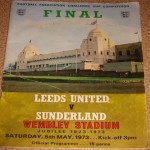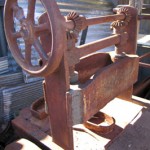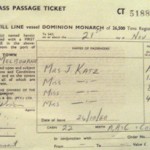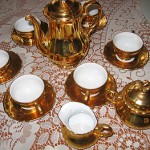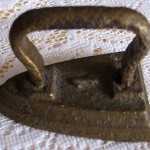Ukrainian
Roznoszynci, Ternopil, Ukraine
Naples, Italy in March 1950
Sydney on 13 April 1950
Bathurst for 1 week
Glen Davis, near Lithgow, NSW
Cook
Cleaning company in Newcastle
I was born on 24th January 1926 in Roznoszynci, a small village near Ternopil in West Ukraine. My maiden name was Stefania Halcun. My husband’s name was Michael Petryk.
My life was hard because I didn’t have parents when I was young. My mother died of pneumonia in May 1939 when I was 12 years of age. I lived then with my grandmother as my grandfather had died before I was born. I have one half-sister and she still lives in Poland.
I can remember a time when I was really, really young; I remember sitting on a path and my grandmother and my mum were planting flowers because it was springtime. I was about six months old. My mother washed me in cold water because we didn’t have any hot water. To make it hot we had to put water on the stove.
I also remember when I was a little bit bigger that she put me on a table and was holding me and singing a song. That song I heard more than once and I still remember it today. I used to go to school in a town called Zbaraz. The year my mother died the Russians came and they stayed for not quite two years. When the Germans came and the Russians retreated, I couldn’t go to school. You had to pay for everything then and my grandmother did not have any money to pay for school.
Afterwards, about 1942, the Germans took me into Germany to work on a farm. The work was very early in the morning to late at night. I ran away, 80 kilometres, from that farm to Munich. I was nearly 17 years old then but I had nothing. I brought nothing over with me to Germany from the West Ukraine.
I met up with a Ukrainian girl from another place, who was also running away. We went to the hotel, Regina Palace, in Munich to get work but the boss from the kitchen sent us to the police first to register. We had been told not to speak German to the police; to pretend we had just come from the Ukraine, nothing else. The police, though, realised I could speak German and sent my friend and I to the Gestapo. The Gestapo called my friend in first and she said she didn’t understand German and they smacked her and she was screaming.
The Gestapo went away and came back with a Ukrainian interpreter who asked questions about how we came to Germany. They thought we were from East Ukraine and maybe Russian spies. That was why they were asking so many questions. The Gestapo man sent us to a camp for almost a fortnight. But because they needed people at the hotel to work, the Gestapo let us go. I saw Hitler come into that hotel with Himmler, Goebbels and Goering. I saw them through the window but we were not allowed to go near them.
I worked in the hotel kitchen from the end of 1943 until the end of January 1944 when Munich was bombed. One bomb went straight into the middle of the hotel. We were safe because we went into the bunkers. I found another job out of the city but still very close. I was working in the kitchen in a Displaced Persons’ camp and I worked there until the war ended. I can’t remember the name of it but it could be the Rosenheim camp.
I met my husband in a camp in Germany in 1944 where a lot of Ukrainian people were. My husband was there with his sister and older brother. His younger brother was in a concentration camp until 1945. We were married in 1946 and bought a house in Munich, Germany and had two children. We stayed there until we decided to come to Australia in 1950.
We came to Australia because Germany was too poor. There was no food; you could only get it on a card. I didn’t like it there. I wanted to go away somewhere, but not the Ukraine. I couldn’t go back there because I knew the Russians were there. Somebody had said that Ukrainians shouldn’t go to Australia because it is a very hot country.
In late January 1950, we got on a train from the Displaced Persons’ camp in Germany to Italy. The ship left from Naples. We went through the Suez Canal to Colombo then straight to Sydney. We came out on the American ship, the Stewart. We arrived in Australia on 13 April 1950 with our two children; my boy Yroslav, who died later in Australia aged 14, and Maria, my first daughter. We went through a big storm on the ship with really big waves and I thought the ship would turn over; it was really scary.
But, somehow, we got to Sydney and arrived during the late afternoon. I thought Sydney was so small. The houses and everything were so small like in villages. Everywhere I saw tents and [it appeared] that not many people lived in houses. I saw some farms. We went straight to Bathurst migrant camp in the train and it was dark when we got there. The next day in the camp, I wanted to drink water and saw that the water was brown. I thought that in all of Australia the water was brown like that!
We only stayed for a short time at the camp, maybe one week, and then went to Glen Davis, which is 80 kilometres past Lithgow through Kandos in NSW. By this time, I had a third child, my daughter Ireana. My husband had work there in the refinery where they made petrol. I came in a car with the children as my husband was already there. When we were nearly there, I thought we were going to drive into a rock wall because we were driving straight at it. I then saw something like a small opening, a “door”, and we drove through. There was a river and right in the middle it was nice and clear, there were mountains everywhere and people were living all around.
I remember once reading a Ukrainian book about Tartars coming [to invade a village]. The story told of Ukrainians living in a village with a river in the middle that came down from the mountains. I thought that Glen Davis was just the same place as I read about in the book.
I looked after the children and we stayed for about a year-and-a-half. Unfortunately, my youngest daughter Ireana passed away at three months of age while we lived at Glen Davis. They ended up closing the refinery down and told us they would pay for us to go anywhere we wanted to go in Australia.
We went to Medowie near Newcastle because my husband already had a sister [there] with her family. We bought nine acres of land. My husband was then working somewhere in Stockton making chairs and things like that. After that job, he was working for the council in Raymond Terrace for some time. Then he went to work at the BHP.
I didn’t like it in Medowie. It was raining and it was too muddy. There were lots of floods in 1952. I had another son and daughter at Medowie. We then shifted to Bull Street, Cooks Hill and two months later, I had another baby daughter, then another son. In 1960 my eldest son, Yroslav, died. The family know all about it so I won’t talk about it.
We bought another house in Stockton, then one in Prince Street, Waratah in Newcastle. Afterwards my husband sold it because he didn’t like the trains so close across the road. He sold the house for £13,000 and bought a Statesman (Holden) car for £10,000. After moving back into Cooks Hill, we saved enough money for a deposit for a house in New Lambton, Newcastle. I was working with a cleaning company then, from 1966 to 1971. We stayed in New Lambton for 20 years. My husband passed away in 1993.
My husband’s second sister gave this wooden leaf to me nearly 20 years ago when she came to Australia. It is something special to remember her by. The shape is like the leaves of some trees in the Ukraine and the flowers are like Ukrainian embroidery.
I embroidered this blouse around the 1980s. It is traditional Ukrainian embroidery, but done in colours that I like. The other blouse [is unique]; I never saw it anywhere except in my village. I don’t know where it came from but it was made when the Polish occupied the Ukraine. It was sent to me in the 1970s when the Ukraine was a Communist country.
I have kept the diary since being in Australia. I have written down everything that I could remember; how it happened, where I was, what I was doing and things like that.
It has been two years since I wrote in the diary. I have not had the time because I have been working getting clothes together to send to the Ukraine for poor people and for children. That is why I don’t even have time for painting. I started painting in 1969.
In the Ukrainian Orthodox Church there was someone teaching children to paint. I told him that when I was going to school I used to sketch and make calendars and sometimes wrote poems. He said, “Well, if you can sketch, you can paint.” And I tried it with the kids. But my husband said I could not go anymore playing with kids’ stuff.
I started to paint at home then. After my husband died, I went straightaway to do watercolour painting at a school. I went from May to December.
I was always scared to leave Australia as I thought I would not be allowed to come back – but I longed to go back to the Ukraine. My son reassured me that I would be allowed back into Australia so in September 2007 my son, his wife and myself embarked on an adventure that I would always remember.
We flew to Germany and found the church where my husband and I exchanged our marriage vows in 1946 but there was no trace of the hotel where I had worked. We then flew to Glubczce in Poland and met my half-sister Genia who I had not seen for 70 years – she was six when I left my village.
We then flew to Iviv, Ukraine. From there, it was several hours by train to Ternopil and 20 minutes by car to my hometown of Roznoszynci.
I was amazed. It appeared that nothing had changed from the time I had left in 1942!
I walked to the cemetery to visit the graves of my mother and grandmother. My grandmother’s house was still standing and it hadn’t changed – no kitchen or bathroom. It was quite obvious that people were still doing it very hard in my old village.
My husband and I said we were lucky and happy to have come to Australia. When we first arrived here, we said we would give this country a go and if it didn’t work out, we could always return to Germany. But, after experiencing living here, we knew that we had made the right decision.
It truly is God’s country.





!["I embroidered the orange and white blouse; it is traditional Ukrainian embroidery but done in colours that I like. The other blouse [is unique]; I never saw it anywhere except in my village."](../../../cms/wp-content/uploads/2009/09/petryk-blouses-150x150.jpg)
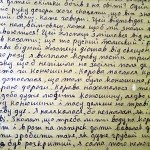
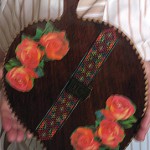
!["I embroidered the orange and white blouse; it is traditional Ukrainian embroidery but done in colours that I like. The other blouse [is unique]; I never saw it anywhere except in my village."](../../../cms/wp-content/uploads/2009/09/petryk-blouses2-150x150.jpg)
